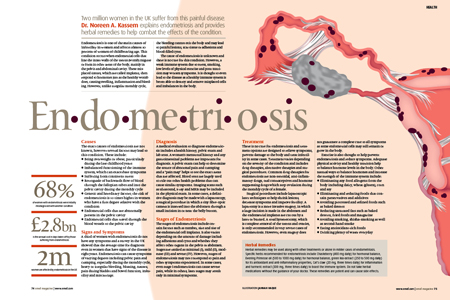
Endometriosis - A special womens health feature
Issue 78 March 2011
Two million women in the UK suffer from this painful disease. Dr. Noreen A. Kassem explains endometriosis and provides herbal remedies to help combat the effects of the condition.
Endometriosis is one of the main causes of infertility in women and affects almost 10 percent of women of childbearing age. This condition occurs when endometrial cells that line the inner walls of the uterus (womb) migrate or form in other areas of the body, mainly in the pelvis and abdominal cavity. These misplaced tissues, which are called implants, then respond to hormones just as the healthy womb does, causing swelling, inflammation and bleeding. However, unlike a regular monthly cycle, the bleeding cannot exit the body and may lead to painful lesions, scar tissue or adhesions and blood-filled cysts.
The cause of endometriosis is unknown and there is no cure for this condition. However, a weak immune system due to stress, smoking, low levels of physical exercise and poor nutrition may worsen symptoms. It is thought to even lead to the disease as a healthy immune system is better able to destroy and remove misplaced cells and imbalances in the body.
Causes
The exact causes of endometriosis are not known, however several factors may lead to this condition. These include:
Being overweight or obese, particularly during the late childhood years
Imbalanced functioning of the immune system, which can exacerbate symptoms
Suffering from consistent stress
Retrograde of backwards flow of blood through the fallopian tubes and into the pelvic cavity during the monthly cycle
Genetic and hereditary factors; the risk of endometriosis is 10 times higher in women who have a first degree relative with the condition
Endometrial cells that are abnormally present in the pelvic cavity
Endometrial cells that travel through the blood vessels to the pelvic cavity
Signs and Symptoms
A third of women with endometriosis do not have any symptoms and a survey in the UK showed that the average time for diagnosis even in women that have signs of the disease is eight years. Endometriosis can cause symptoms of varying degrees including pelvic pain and cramping, especially during the monthly cycle, heavy or irregular bleeding, bloating, nausea, pain during bladder and bowel function, infertility and miscarriage.
Diagnosis
A medical evaluation to diagnose endometriosis includes a health history, pelvic exam and lab tests. A woman’s menstrual history and any gastrointestinal problems are important for diagnosis. A pelvic exam can help to determine the source of abnormal pain and cramping and a “pain map” helps to see the exact areas that are affected. Blood tests are largely used to rule out other health problems that can cause similar symptoms. Imaging scans such as ulrasound, x-ray and MRIs may be included in the physical exam. In some cases, a definitive diagnosis may be made with a laparoscopy, a surgical procedure in which a tiny fibre-optic camera is inserted into the abdomen through a small incision in or near the belly button.
777777
Stages of Endometriosis
The stages of endometriosis include certain factors such as number, size and site of the endometrial cell implants. It also varies depending on the amount of damage including adhesions and cysts and whether they affect other organs in the pelvis or abdomen. Stages are ranked as minimal (I), mild (II), moderate (III) and severe (IV). However, stages of endometriosis may not correspond to pain and other symptoms experienced. In some cases, even stage I endometriosis can cause severe pain, while in others, later stages may result only in minimal symptoms.
Treatment
There is no cure for endometriosis and treatment options are designed to relieve symptoms, prevent damage to the body and treat infertility in some cases. Treatment varies depending on the severity of the condition and includes drug therapies, alternative therapies and surgical procedures. Common drug therapies for endometriosis are non-steroidal, anti-inflammatory drugs, oral contraceptives and hormone suppressing drugs which stop ovulation during the monthly cycle of a female.
Surgical procedures include laparoscopic laser techniques to help shrink lesions, decrease symptoms and improve fertility. A lapartomy is a more invasive surgery, in which a large incision is made in the abdomen and the endometrial implants are cut out by a laser or burned. A total hysterectomy, which is complete removal of the uterus and ovaries, is only recommended in very severe cases of endometriosis. However, even surgery does not guarantee a complete cure to all symptoms as some endometrial cells may still remain or grow in the body.
Exercise is also thought to help prevent endometriosis and reduce symptoms. Adequate physical activity and healthy nutrition help to balance hormone levels in the body. Other natural ways to balance hormones and increase the strength of the immune system include:
Eliminating any food allergens from the body including dairy, wheat (gluten), corn and soy
Eliminating and reducing foods that contain preservatives and additives
Avoiding processed and refined foods such as baked deserts
Reducing saturated fats such as baked deserts, fried foods and margarine
Avoiding smoking, shisha-smoking as well as second-hand smoke
Eating antioxidant-rich foods
Drinking plenty of water everyday
Herbal Remedies
Herbal remedies may be used along with other treatments or alone in milder cases of endometriosis. Specific herbs recommended for endometriosis include Chasteberry (400 mg daily) for hormonal balance, Evening Primrose oil (500 to 1000 mg daily) for hormonal balance, green tea extract (250 to 500 mg daily) for its antioxidant and anti-inflammatory properties, Cat’s claw (20 mg, three times daily) for inflammation and turmeric extract (300 mg, three times daily) to boost the immune system. Do not take herbal medications without the guidance of your doctor. These remedies are potent and can cause side effects.
Click here to read more of our health features
Bookmark this |
|
Add to DIGG |
|
Add to del.icio.us |
|
Stumble this |
|
Share on Facebook |
|
Share this |
|
Send to a Friend |
|
Link to this |
|
Printer Friendly |
|
Print in plain text |
|


Comments
1 Comment
1
Kelli Sayfullah
22 Mar 11, 17:08
SubhanAllah this is a great education as some can
exactly relate. Alhamdulillah for the muslim doctors in
favour for us sisters